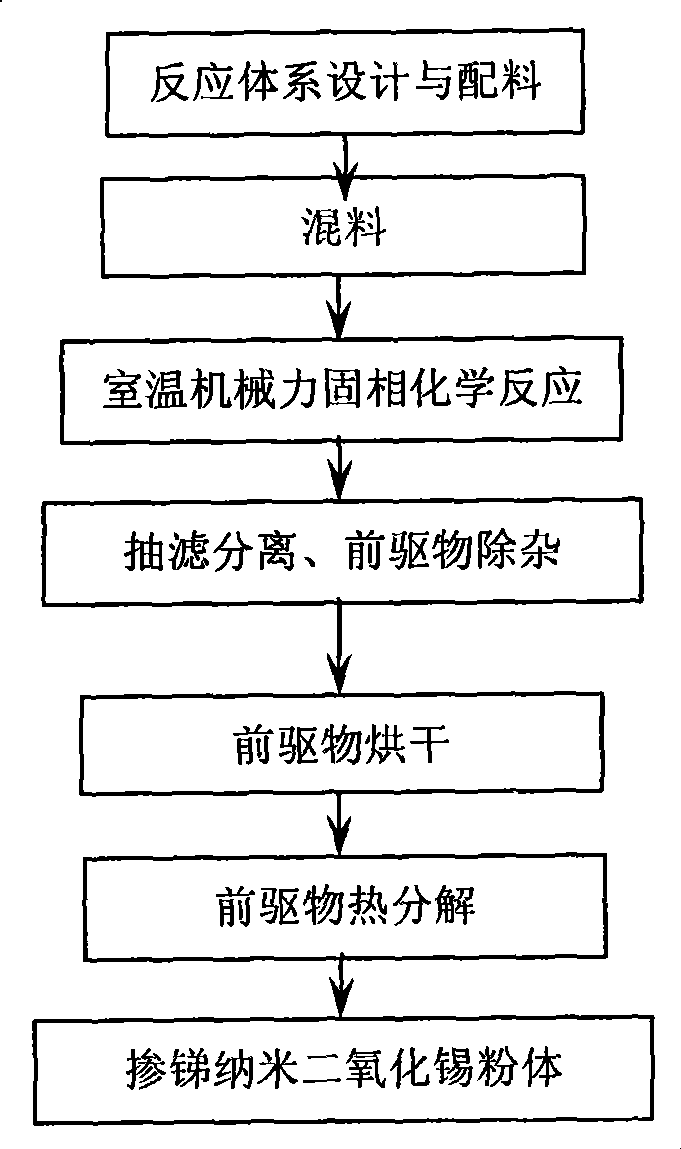Room temperature mechanical force solid phase chemical reaction preparation of antimony-doped nano stannic oxide
A nano-tin dioxide, solid-phase chemical reaction technology, applied in fibrous fillers and other directions, can solve the problems of difficult to achieve uniform mixing, hydrolysis of tin ions, slow reaction speed, etc., to achieve shortened chemical reaction time, constant concentration, and improved diffusion. effect of speed
- Summary
- Abstract
- Description
- Claims
- Application Information
AI Technical Summary
Problems solved by technology
Method used
Image
Examples
Embodiment 1
[0027] In this embodiment, the reactants are stannous chloride and antimony trichloride, and the ligand is oxalic acid. The process flow is as follows: figure 1 As shown, there are the following steps in sequence
[0028] 1. Ingredients
[0029] The molar ratio of stannous chloride, antimony trichloride and oxalic acid is 1:2, wherein the molar ratio of stannous chloride and antimony trichloride is 10:1;
[0030] 2. Mixing
[0031] Mix the proportion of stannous chloride, antimony trichloride and oxalic acid until uniform;
[0032] 3. Preparation of precursors by mechanical solid-phase chemical reaction method
[0033] The uniformly mixed stannous chloride, antimony trichloride and oxalic acid are ball milled at room temperature and normal pressure, so that they react to form precursors under the mechanical shear force and impact force generated during the ball milling process, and the speed of the ball mill is controlled At 300 rpm, ball milling for 50 minutes can complet...
Embodiment 2
[0041] In this embodiment, the reactants are stannous sulfate and antimony trichloride, and the ligand is ammonium carbonate. The process flow is as follows: figure 1 As shown, there are the following steps in sequence:
[0042] 1. Ingredients
[0043] The molar ratio of the total amount of stannous sulfate and antimony trichloride to ammonium carbonate is 1:3, wherein the molar ratio of stannous sulfate and antimony trichloride is 15:1;
[0044] 2. Mixing
[0045] Mix the proportioned stannous sulfate, antimony trichloride and ammonium carbonate until uniform;
[0046] 3. Preparation of precursors by mechanochemical reaction method
[0047] The uniformly mixed stannous sulfate, antimony trichloride and ammonium carbonate are ball milled at room temperature and normal pressure, so that they react to form precursors under the action of mechanical shear force and impact force generated during the ball milling process. The speed of the ball mill is at 350 rpm, ball milling fo...
Embodiment 3
[0055] In this embodiment, the reactants are tin chloride and antimony sulfate, and the ligand is oxalic acid. The process flow is as follows: figure 1 As shown, there are the following steps in sequence:
[0056] 1. Ingredients
[0057] The molar ratio of tin chloride, antimony sulfate total amount and oxalic acid is 1:5, wherein the molar ratio of tin chloride, antimony sulfate is 12:1;
[0058] 2. Mixing
[0059] Mix tin chloride, antimony sulfate and oxalic acid in proportion until uniform;
[0060] 3. Preparation of precursors by mechanochemical reaction method
[0061] The uniformly mixed reaction system is ball milled at room temperature and normal pressure, so that it reacts to form a precursor under the action of mechanical shear force and impact force generated during the ball milling process. It can completely react tin chloride, antimony sulfate and oxalic acid to form precursors;
[0062] 4. Precursor removal
[0063] The precursor is removed by washing and fi...
PUM
 Login to View More
Login to View More Abstract
Description
Claims
Application Information
 Login to View More
Login to View More - R&D
- Intellectual Property
- Life Sciences
- Materials
- Tech Scout
- Unparalleled Data Quality
- Higher Quality Content
- 60% Fewer Hallucinations
Browse by: Latest US Patents, China's latest patents, Technical Efficacy Thesaurus, Application Domain, Technology Topic, Popular Technical Reports.
© 2025 PatSnap. All rights reserved.Legal|Privacy policy|Modern Slavery Act Transparency Statement|Sitemap|About US| Contact US: help@patsnap.com

